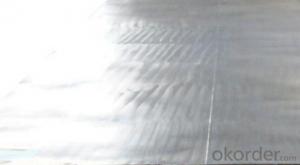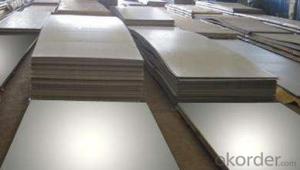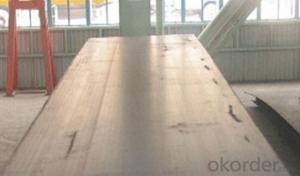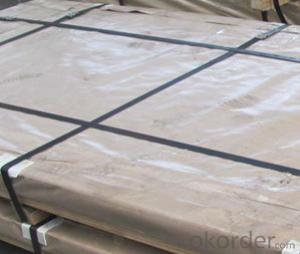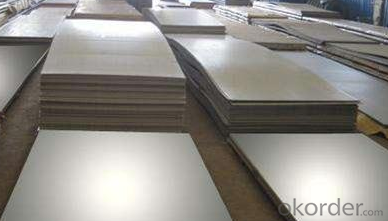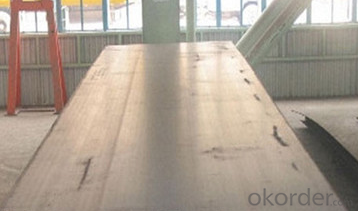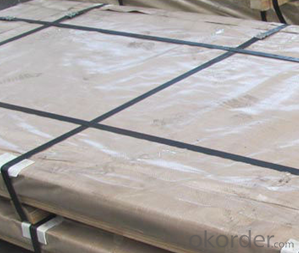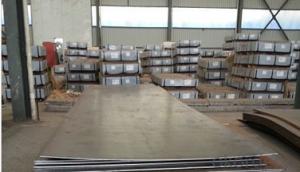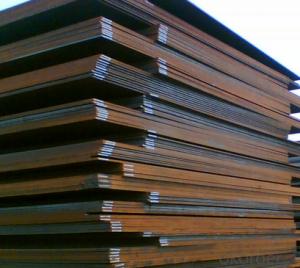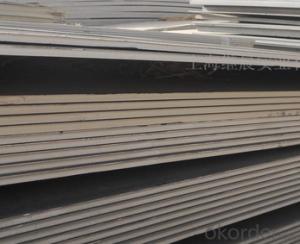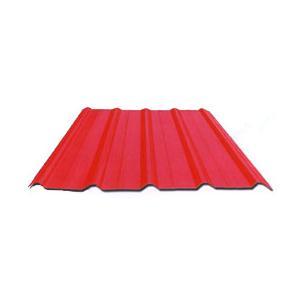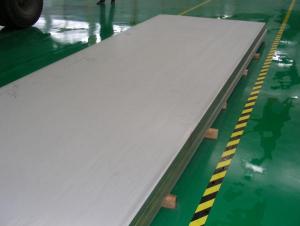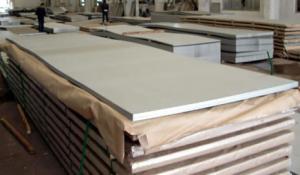Hot Rolled Carbon Steel Sheet Plate, ASTM A36 CNBM
- Loading Port:
- Qingdao
- Payment Terms:
- TT OR LC
- Min Order Qty:
- 10 pc
- Supply Capability:
- 30 pc/month
OKorder Service Pledge
Quality Product, Order Online Tracking, Timely Delivery
OKorder Financial Service
Credit Rating, Credit Services, Credit Purchasing
You Might Also Like
Quick Details
| Standard: | AISI, ASTM, DIN, GB, JIS | Grade: | A572,A573,A633,A678,A709,A710,G3101,G3136,etc | Thickness: | 1mm-200mm |
| Brand Name: | SHOU GANG GROUP, AN STEEL | Model Number: | Q235 | ||
| Type: | Steel Plate | Technique: | Hot Rolled | Surface Treatment: | Coated |
| Application: | widely | Special Use: | High-strength Steel Plate | Width: | 1000mm-3000mm |
| Length: | 1000mm-12000mm | Price Term: | FOB CIF CFR |
Packaging & Delivery
| Packaging Details: | standard seaworthy export packing or as the request of customers |
| Delivery Detail: | 10 days after deposit or according to customers' quantity |
Specifications
hot rolled carbon steel sheet
1.Thickness:1mm-200mm
2.Length:1000mm-12000mm
3.Width:1000mm-2000mm
hot rolled carbon steel sheet
| Product | HR steel plate prices carbon steel plate prices per kg |
| MOQ | 25 ton |
| Thickness | 1mm-200mm |
| Width | 1000mm-3000mm |
| Length | 1000mm-12000mm |
| Application | widely |
| Standard | AISI,ASTM,BS,DIN,JIS,GB,etc |
| Grade | A572,A573,A633,A678,A709,A710,G3101,G3136,etc |
| Tpye | Steel plate |
| Surfacing | Coated |
| Productive Technology | Hot Rolled & Cold Rolled |
| Port | |
| Payment Terms | L/C,T/T,Western Union,MoneyGram |
| Product Ability | 5000 tons per month |
| Delivery | 10 days after deposit or according to customers' quantity |
| Packing | standard seaworthy export packing or as the request of customers |
- Q: What are the different edge treatments for steel sheets?
- There are several different edge treatments that can be applied to steel sheets depending on the desired functionality and aesthetics. Some of the common edge treatments for steel sheets include: 1. Deburring: This process involves removing any burrs or sharp edges that may have formed during the manufacturing process. Deburring is done to improve safety and prevent injuries during handling and installation. 2. Beveling: Beveling is the process of creating a sloping edge on the steel sheet. It is often done to facilitate welding or joining of multiple sheets together. Beveled edges provide a smooth transition and increase the strength of the joint. 3. Chamfering: Similar to beveling, chamfering involves creating a beveled edge on the steel sheet. However, chamfering is primarily done for aesthetic purposes to provide a finished and polished look to the edges. 4. Hemming: Hemming is a technique used to bend the edge of a steel sheet back onto itself. It is commonly used in automotive and appliance industries to create a safe and smooth edge that eliminates the need for additional finishing or edge protection. 5. Rolled edges: Rolled edges are achieved by bending the edge of the steel sheet in a curved or rounded shape. This type of edge treatment is often employed to enhance structural integrity, reduce the risk of injury, and improve the overall appearance of the sheet. 6. V-grooving: V-grooving is a process of cutting a V-shaped groove along the edge of the steel sheet. This treatment is commonly used for decorative purposes or to create a clean and precise joint when multiple sheets are being joined together. 7. Flanging: Flanging involves bending or folding the edge of the steel sheet at a specific angle. This treatment is often used to increase rigidity and strength along the edge, especially in applications where the sheet needs to support weight or resist bending. Each of these edge treatments serves a specific purpose and can be selected based on the specific requirements of the project. It is important to consider factors such as functionality, safety, aesthetics, and ease of fabrication when choosing the appropriate edge treatment for steel sheets.
- Q: What is the maximum temperature resistance of steel sheets?
- The maximum temperature resistance of steel sheets typically depends on the specific grade of steel being used, but in general, most steel sheets can withstand temperatures up to around 1,500 degrees Fahrenheit (815 degrees Celsius) without significant structural damage.
- Q: Can steel sheets be used in the food processing industry?
- Yes, steel sheets can be used in the food processing industry. Steel is a popular choice for food processing equipment and materials due to its strength, durability, and corrosion resistance. It is commonly used in the construction of food storage tanks, conveyor belts, cutting surfaces, and other machinery. Additionally, steel sheets can be easily cleaned and sanitized, making them suitable for maintaining high hygiene standards in food processing facilities.
- Q: Are steel sheets suitable for high-pressure applications?
- Yes, steel sheets are suitable for high-pressure applications due to their exceptional strength, durability, and resistance to deformation. Steel sheets can withstand high levels of pressure without compromising their structural integrity, making them a reliable choice for various industrial and manufacturing processes that require containment or resistance to pressure.
- Q: Can steel sheets be used for magnetic applications?
- Yes, steel sheets can be used for magnetic applications. However, it is important to note that not all types of steel are magnetic. Steel can be classified into two main categories: ferromagnetic and non-ferromagnetic. Ferromagnetic steel contains iron, nickel, and cobalt, which are materials that can be magnetized. On the other hand, non-ferromagnetic steel does not contain these materials and is not magnetic. Ferromagnetic steel sheets are commonly used in magnetic applications such as transformers, motors, generators, and magnetic shielding. They are preferred for these applications because they can easily conduct and amplify magnetic fields. Non-ferromagnetic steel sheets, although not magnetic themselves, can still be used in magnetic applications as structural components or as part of a magnetic system where the magnetic field is being controlled or manipulated. When selecting steel sheets for magnetic applications, it is important to consider the specific magnetic properties required for the intended application and choose the appropriate type of steel accordingly.
- Q: Can steel sheets be used for heat exchangers or boilers?
- Yes, steel sheets can be used for heat exchangers or boilers. Steel is a commonly used material in the construction of heat exchangers and boilers due to its high strength, durability, and resistance to corrosion at high temperatures. Additionally, steel sheets can be easily formed and welded to create the required shapes and structures for efficient heat transfer.
- Q: Can steel sheets be used for signage or displays?
- Yes, steel sheets can definitely be used for signage or displays. Steel is a versatile material that offers durability and strength, making it suitable for both indoor and outdoor applications. Steel sheets can be cut, bent, or welded into various shapes and sizes, allowing for the creation of custom signage or displays. The smooth surface of steel sheets provides an excellent canvas for painting, printing, or applying vinyl graphics, making them ideal for showcasing logos, messages, or visual content. Additionally, steel sheets can be powder coated or galvanized to enhance their resistance to corrosion, ensuring long-lasting and attractive signage or displays.
- Q: How do steel sheets perform in terms of dimensional stability?
- Steel sheets are known for their excellent dimensional stability. This means that they are highly resistant to changes in size or shape when subjected to external forces or fluctuations in temperature. Steel is inherently strong and rigid, allowing it to maintain its shape and dimensions over extended periods of time. Additionally, steel sheets have low thermal expansion coefficients, meaning they expand and contract minimally with changes in temperature. This characteristic further enhances their dimensional stability, making them suitable for applications where precise dimensions and consistent performance are critical. Steel sheets are widely used in various industries, including construction, automotive, and manufacturing, due to their reliable dimensional stability.
- Q: What is the electromagnetic steel plate in the generator?
- Looks like in the game but did not listen to the words, said in real life. Not heard of steel sheet of motor core
- Q: What is the process of cold rolling steel sheets?
- The process of cold rolling steel sheets involves passing hot-rolled steel through a set of rollers at room temperature to reduce its thickness and improve its surface finish. This process is typically done in multiple passes, gradually reducing the thickness of the steel while maintaining its strength. Cold rolling also imparts desirable mechanical properties to the steel, such as increased hardness and improved dimensional accuracy.
Send your message to us
Hot Rolled Carbon Steel Sheet Plate, ASTM A36 CNBM
- Loading Port:
- Qingdao
- Payment Terms:
- TT OR LC
- Min Order Qty:
- 10 pc
- Supply Capability:
- 30 pc/month
OKorder Service Pledge
Quality Product, Order Online Tracking, Timely Delivery
OKorder Financial Service
Credit Rating, Credit Services, Credit Purchasing
Similar products
Hot products
Hot Searches
Related keywords
